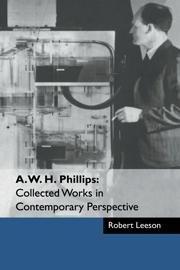Book contents
- Frontmatter
- Contents
- List of contributors
- Foreword by Arthur Brown
- Preface by Robert Leeson
- Part I Bill Phillips: Some Memories and Reflections
- Part II The Phillips Machine
- Part III Dynamic Stabilisation
- 15 The optimal control articles
- 16 Stabilisation policy in a closed economy
- 17 Stabilisation policy and the time-forms of lagged responses
- 18 Arnold Tustin's The Mechanism of Economic Systems: a review
- 19 Michel Kalecki's Theory of Economic Dynamics: An Essay on Cyclical and Long-Run Changes in the Capitalist Economy: a review
- 20 The growth articles
- 21 A simple model of employment, money and prices in a growing economy
- 22 Employment, inflation and growth
- 23 Economic policy and development
- 24 The famous Phillips Curve article
- 25 The relation between unemployment and the rate of change of money wage rates in the United Kingdom, 1861-1957
- 26 Discussion of Dicks-Mireaux and Dow's The Determinants of Wage Inflation: United Kingdom, 1946-1956
- 27 The Melbourne paper
- 28 Wage changes and unemployment in Australia, 1947-1958
- 29 Phillips and stabilisation policy as a threat to stability
- 30 The Phillips Curve in macroeconomics and econometrics
- 31 Bill Phillips' contribution to dynamic stabilisation policy
- 32 A Left Keynesian view of the Phillips Curve trade-off
- 33 Interactions with a fellow research engineer-economist
- 34 Does modern econometrics replicate the Phillips Curve?
- 35 The famous Phillips Curve article: a note on its publication
- Part IV Econometrics
- References
- Index of names
- Index of subjects
34 - Does modern econometrics replicate the Phillips Curve?
Published online by Cambridge University Press: 04 May 2010
- Frontmatter
- Contents
- List of contributors
- Foreword by Arthur Brown
- Preface by Robert Leeson
- Part I Bill Phillips: Some Memories and Reflections
- Part II The Phillips Machine
- Part III Dynamic Stabilisation
- 15 The optimal control articles
- 16 Stabilisation policy in a closed economy
- 17 Stabilisation policy and the time-forms of lagged responses
- 18 Arnold Tustin's The Mechanism of Economic Systems: a review
- 19 Michel Kalecki's Theory of Economic Dynamics: An Essay on Cyclical and Long-Run Changes in the Capitalist Economy: a review
- 20 The growth articles
- 21 A simple model of employment, money and prices in a growing economy
- 22 Employment, inflation and growth
- 23 Economic policy and development
- 24 The famous Phillips Curve article
- 25 The relation between unemployment and the rate of change of money wage rates in the United Kingdom, 1861-1957
- 26 Discussion of Dicks-Mireaux and Dow's The Determinants of Wage Inflation: United Kingdom, 1946-1956
- 27 The Melbourne paper
- 28 Wage changes and unemployment in Australia, 1947-1958
- 29 Phillips and stabilisation policy as a threat to stability
- 30 The Phillips Curve in macroeconomics and econometrics
- 31 Bill Phillips' contribution to dynamic stabilisation policy
- 32 A Left Keynesian view of the Phillips Curve trade-off
- 33 Interactions with a fellow research engineer-economist
- 34 Does modern econometrics replicate the Phillips Curve?
- 35 The famous Phillips Curve article: a note on its publication
- Part IV Econometrics
- References
- Index of names
- Index of subjects
Summary
Introduction
It is probably fair to say that the analysis of the wage-price mechanism is one of the areas of applied macroeconomics that has received most atten- tion. This is, of course, especially true ever since chapter 25 was first published in 1958. The ‘Phillips Curve’ became, at first, an essential, and then a controversial ingredient of macro-models of the economy. Over the years, numerous studies have been undertaken in different countries, to estimate and test many variants of the Phillips Curve. Although there are some results with which most economists seem to agree, one is nevertheless left with the impression that the empirical evidence for or against the existence of a stable long-term relationship between the rate of change of wages (or of prices) and the rate of unemployment remains contradictory.
The last decade has seen much development in dynamic econometric modelling of economic time series. These developments, which have gone mainly ignored in most empirical studies of the wage-price mechanism, concern issues related to the exogeneity of variables, cointegration or the existence of a long-run relation between ‘integrated’ economic variables, and finally single equation versus system modelling. Much of the empirical evidence reviewed in Nickell (1990a) and in Bean (1994) is based on the estimation of conditional wage and price equations. If the regressor variables can legitimately be assumed to be weakly exogenous for the parameters of interest in the conditional model, then efficient estimation and testing may be conducted by analysing only the conditional model.
- Type
- Chapter
- Information
- A. W. H. Phillips: Collected Works in Contemporary Perspective , pp. 315 - 334Publisher: Cambridge University PressPrint publication year: 2000
- 1
- Cited by



